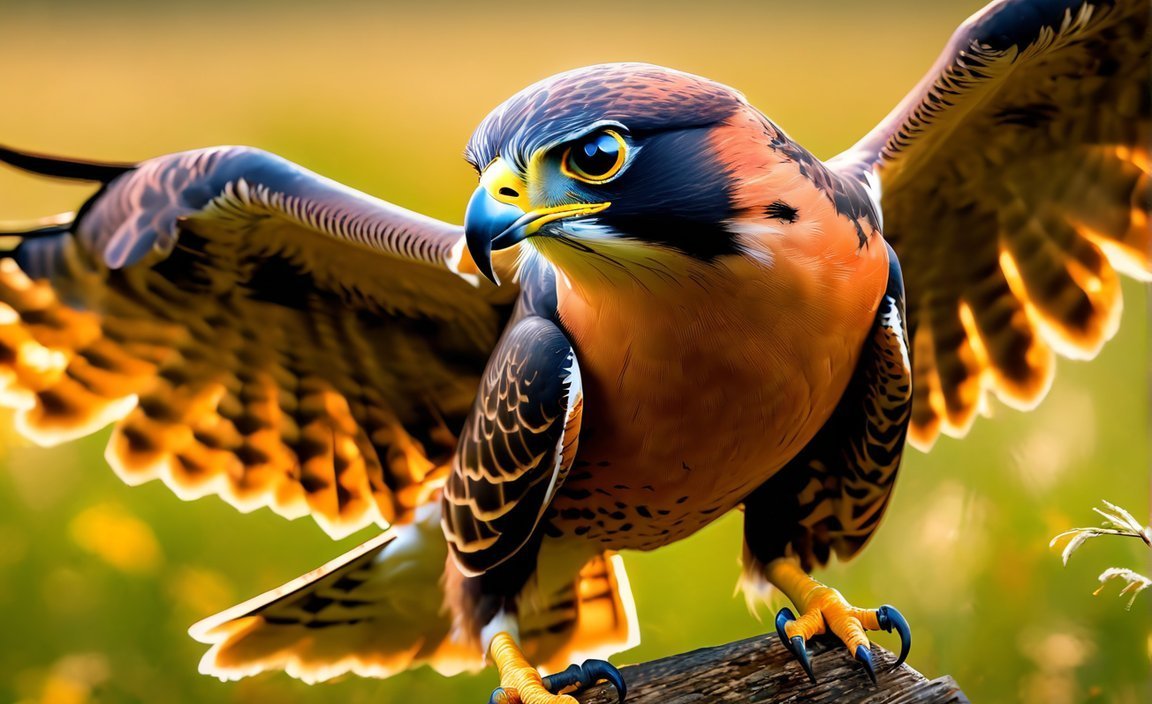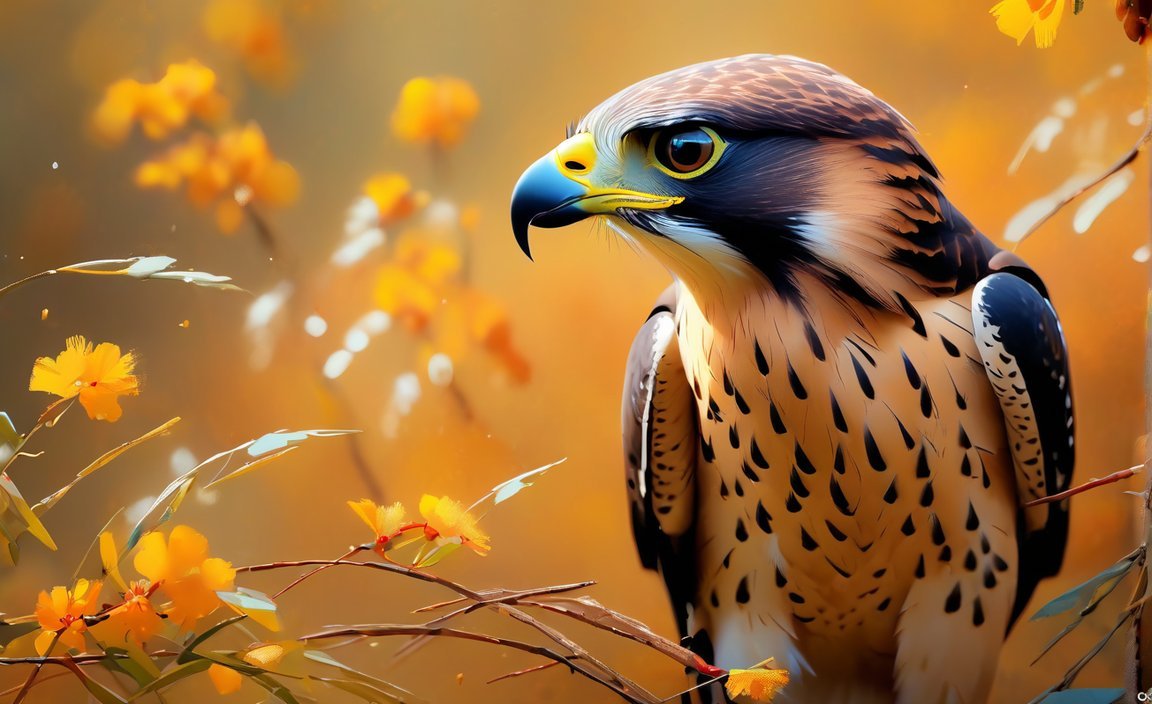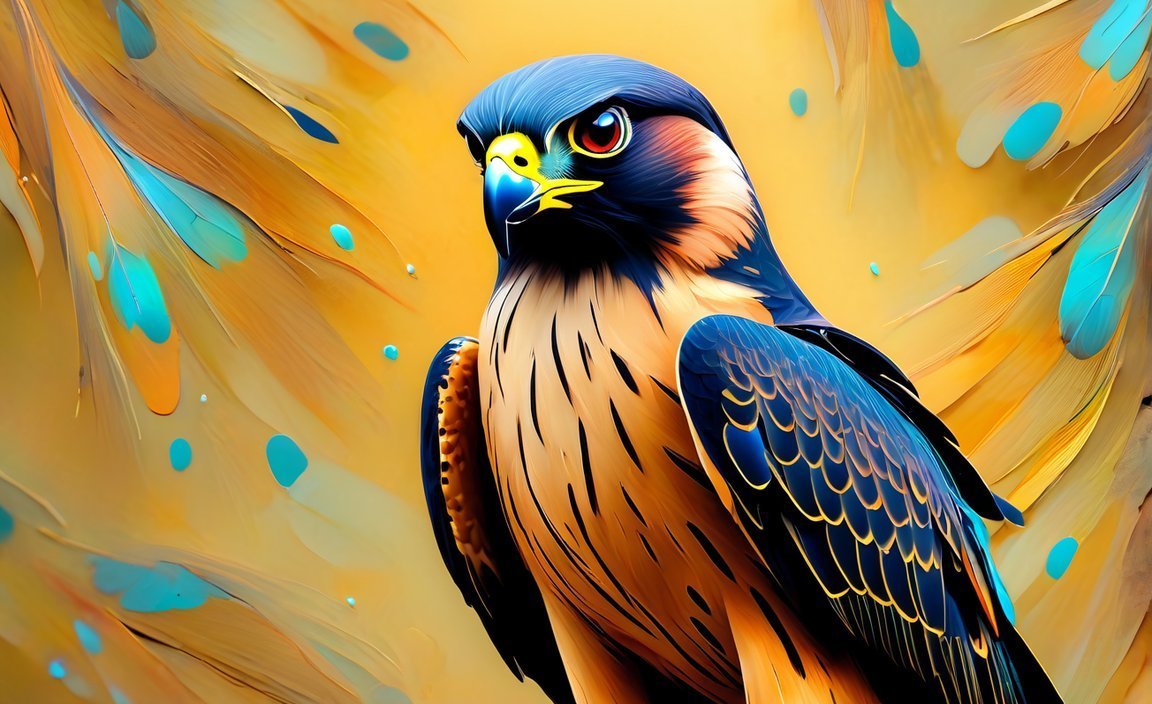Get ready to soar through the fascinating world of falcons as we uncover 10 intriguing insights into these remarkable avian hunters. Falcons have long captured the imaginations of bird enthusiasts and wildlife lovers alike, with their stunning aerial displays and awe-inspiring hunting techniques. From their incredible speed and agility to their diverse species and crucial role in maintaining ecological balance, we’ll delve into the captivating facts that make falcons one of nature’s true marvels. Join us on this journey as we unveil the secrets behind these magnificent creatures and shed light on their extraordinary lives.

Key Takeaways:
- Falcons are sexually dimorphic, with differences in size, color, and plumage between males and females. This makes it easier to identify the sexes.
- There are more than 40 species of falcons found in various habitats worldwide.
- Peregrine falcons, a type of falcon, can adapt to both urban and rural areas and can be found worldwide.
- The peregrine falcon is the fastest type of falcon, reaching speeds of up to 242 miles per hour while diving.
- Falcons have tubercles on their nostrils that help direct airflow during high-speed dives, allowing them to breathe more efficiently.
- Falcons mate for life and raise their offspring cooperatively.
- Female falcons exhibit the “stooping” behavior of flying upside-down to attract a mate.
- Falcons are highly trainable due to their intelligence and natural instincts.
- Falcons have a long history of being used for hunting, particularly in falconry, where they catch small game.
- Falcons were also trained and used for military purposes during World War 2.
These fascinating facts shed light on the unique characteristics, behaviors, and historical significance of falcons as admired birds known for their speed, agility, and hunting abilities.
10 Interesting Facts About Falcons
Falcons, with their incredible speed and hunting abilities, are among the most fascinating birds in the avian kingdom. From their unique characteristics to their historical significance, here are 10 intriguing insights into these avian hunters.
1. Falcons Are Sexually Dimorphic
One of the interesting facts about falcons is that they exhibit sexual dimorphism. This means that there are differences in size, color, and plumage between males and females, making it easier to identify the sexes. It’s like they have their own distinct personalities!
2. Falcons Come in Many Species
Did you know that there are more than 40 species of falcons? These species are divided into different subgroups and can be found in various habitats around the world. It’s truly remarkable to see the diversity among these majestic birds.
3. Peregrine Falcons Rule Everywhere
One type of falcon that stands out is the peregrine falcon, which can be found in all parts of the world, from urban areas to rural landscapes. They are highly adaptable and can make their homes in a wide range of environments. Talk about conquering the world!
4. Peregrine Falcons Are Speed Demons
Hold on tight for this fact: the peregrine falcon is the fastest type of falcon in the world. When diving for prey, it can reach speeds of up to 242 miles per hour! That’s faster than most cars on the highway. These birds are true speedsters.
5. Falcons Have Nostril Bumps
Have you ever noticed the small bumps on a falcon’s nostrils? These bumps, called tubercles, actually help direct airflow during their high-speed dives. This allows falcons to breathe more efficiently and helps them maintain their extraordinary hunting abilities. It’s like nature’s built-in turbocharger!
6. Falcons Are Loyal Mates
When it comes to love, falcons are in it for the long haul. Once they find a suitable partner, they mate for life and raise their offspring cooperatively. It’s a beautiful display of loyalty and teamwork in the avian world.
7. Female Falcons Know How to Impress
Female falcons have quite the impressive courtship behavior. They showcase their agility and skill by flying upside down in what’s known as “stooping.” It’s their way of attracting a potential mate and showing off their prowess in the sky. Talk about impressive acrobatics!
8. Falcons Are Natural Born Learners
With their intelligence and natural instincts, falcons are one of the easiest birds to train. They have been used in falconry and other forms of bird training for centuries. It’s amazing to witness their ability to learn and adapt to human commands.
9. Falcons: Ancient Hunting Partners
The partnership between humans and falcons can be traced back thousands of years. Falcons have been trained by humans to help catch small game like birds and rabbits. Their hunting prowess made them valuable assets for hunters throughout history.
10. Falcons at War
During World War II, falcons had a special role to play. They were actually trained for military purposes, such as delivering messages and intercepting enemy carrier pigeons. These birds became indispensable in wartime strategies and showcased their cleverness and loyalty.
So there you have it, 10 interesting facts about falcons that shed light on their extraordinary characteristics, behaviors, and historical significance. These avian hunters never cease to amaze us with their speed, agility, and hunting prowess.
If you’re curious about hawksbill sea turtles, you won’t believe these 10 fun facts! From their incredible shell patterns to their unique feeding habits, these turtles are truly fascinating. Discover more about these amazing creatures here.
Did you know that dogs can enjoy some human foods? Check out this list of 10 human foods that are safe for your furry friend to eat. Don’t miss out on these tasty treats for your dog’s next snack time! Find the list here.
Looking for nutritious options to feed your dog? Look no further! We have compiled a list of 10 human foods that are not only safe but also beneficial for your dog’s health. Discover these superfoods here.
Prepare to be amazed by these 10 interesting facts about alligator snapping turtles. From their powerful jaws to their unique camouflage, these creatures are truly fascinating. Dive into the world of these turtles here.
Have you ever wondered what it’s like to be a veterinarian? Check out these 10 interesting facts about the amazing world of veterinary medicine. From saving lives to caring for animals, being a veterinarian is an extraordinary profession. Explore these facts here.
Delve into the captivating world of hawksbill sea turtles with these 10 interesting facts. From their role in coral reef ecosystems to their endangered status, these turtles have a lot to offer. Learn more about hawksbill sea turtles here.
Discover the fascinating facts about hawksbill turtles with this intriguing list of 10 interesting facts. From their migratory patterns to their unique shell characteristics, there’s so much to know about these incredible creatures. Dive deeper into the world of hawksbill turtles here.
Prepare to be amazed by these 10 interesting facts about snapping turtles. From their powerful jaws to their ability to live in various habitats, these remarkable creatures have some surprising traits. Discover more about snapping turtles here.
Uncover the wonders of the hawksbill sea turtle with these 10 interesting facts. From their role in maintaining coral reef health to their beautiful shell patterns, these turtles are a true marvel of nature. Learn more about the hawksbill sea turtle here.
Falcon Speed and Agility
Falcons are renowned for their unmatched speed and agility. These extraordinary avian hunters possess remarkable abilities that set them apart from other birds. Let’s dive into some fascinating facts about falcon speed and agility.
1. The Fastest Animals on Earth
Falcons hold the title for being the fastest animals on record. Among all falcon species, the peregrine falcon reigns supreme in terms of speed. It has been recorded diving at incredible speeds of up to 242 miles per hour, leaving other creatures in the dust. Their lightning-fast flight makes them unparalleled in the animal kingdom[^1^].
2. Masters of Aerial Acrobatics
Not only are falcons fast, but they are also highly maneuverable in flight. Their agility allows them to perform breathtaking aerial acrobatics. Falcons can make tight turns and sudden changes in direction with ease, showcasing their precise control over their movements. Their unique wing shape and structure enable them to navigate through the air with unmatched skill and precision[^1^].
3. Adaptability to Various Habitats
Falcons are incredibly adaptable birds, capable of thriving in diverse habitats across the globe. With the exception of Antarctica, falcons can be found on every continent. From deserts to mountains to coastal areas, they have successfully adapted to various environmental challenges. This adaptability makes them a versatile group of birds with a wide distribution[^2^].
4. Precision Hunters
Falcons are skilled hunters that rely on their exceptional speed and agility to capture their prey. They primarily target small to medium-sized birds, chasing them in swift aerial pursuits. Falcons possess eyesight that is eight times more powerful than that of humans, allowing them to spot their prey from great distances. Their keen vision combined with their hunting prowess makes them formidable predators[^3^].
5. Humans and Falconry
For thousands of years, falcons have formed a partnership with humans in the art of falconry. This ancient practice involves training falcons for hunting purposes. Falcons’ speed, agility, and keen eyesight make them excellent companions for capturing game animals. Falconry holds deep cultural significance and continues to be appreciated in various parts of the world[^4^].
6. Lifelong Bonds
Falcons are known for their strong sense of fidelity. They form lifelong pair bonds and remain loyal to their mates throughout their lives. This unique trait of monogamy sets falcons apart from many other bird species, highlighting their commitment to their partners and their young[^1^].
7. Symbolism in Cultures
Falcons hold significant symbolic power in various cultures. In ancient Egypt, the peregrine falcon’s head symbolized the sun god Ra. During the Middle Ages in Europe, the peregrine falcon was regarded as a majestic bird, occupying a position of importance among birds of prey. These symbols illustrate the awe-inspiring qualities and grace associated with falcons[^5^].
8. Conservation Efforts for Falcons
Due to factors such as habitat loss, pollution, and illegal hunting, some species of falcons face threats to their survival. To ensure their long-term survival, conservation organizations and researchers are actively engaged in efforts to protect falcons and their habitats. These initiatives play a vital role in preserving the natural heritage represented by falcons and their ecological roles[^6^].
Key Takeaways:
- Falcons are the fastest animals on Earth, with the peregrine falcon reaching speeds of up to 242 miles per hour.
- They showcase remarkable agility and perform breathtaking aerial acrobatics.
- Falcons exhibit great adaptability and can thrive in diverse habitats across every continent except Antarctica.
- These expert hunters rely on their exceptional speed and precision to capture their prey.
- Falconry is an ancient practice that showcases the partnership between humans and falcons.
- Falcons form lifelong pair bonds and demonstrate a strong sense of fidelity.
- Falcons hold significant symbolic power in various cultures.
- Conservation efforts are crucial for protecting falcons and their habitats.
Sources:
– Smithsonian Magazine
– Cool Kid Facts
Falcon adaptations and specializations
Falcons, with their impressive hunting abilities and unique characteristics, have adapted and specialized over time to become formidable avian hunters. Let’s dive into ten intriguing facts about falcons that highlight their fascinating adaptations and specializations.
1. Incredible Speed and Agility
Falcons are renowned for their incredible speed and agility, making them some of the fastest animals on the planet. The peregrine falcon, in particular, holds the title for being the fastest bird in the world. With speeds reaching up to 242 miles per hour when diving for prey, these birds have honed their adaptations to become true aerial speedsters.
2. Adaptations for Precision Hunting
To achieve their impressive hunting success, falcons have evolved specialized adaptations. One such adaptation is the presence of tubercles, small bumps on their nostrils. These tubercles help to channel and control airflow during high-speed flight, enhancing their maneuverability and precision while hunting.
3. Sharp Vision
Falcons possess incredibly sharp vision, which plays a crucial role in their hunting strategies. Their eyes are adapted to detect prey from great distances, with some falcons having up to eight times better visual acuity compared to humans. This exceptional eyesight enables them to spot their prey in flight and execute precise aerial attacks.
4. Powerful Talons for Capture
Falcons have evolved powerful hooked talons, designed specifically for capturing and gripping their prey. These razor-sharp talons enable them to grasp their target firmly, ensuring a secure hold while in flight. Once captured, falcons use their sharp beaks to quickly dispatch their prey.
5. Adapted Beak for Efficient Feeding
The beak of a falcon is perfectly adapted for its specific diet. It features a sharp, notched upper mandible that allows for efficient tearing of the prey’s flesh. This adaptation enables falcons to consume their meals swiftly, ensuring they don’t waste precious energy during the feeding process.
6. Specialized Hunting Techniques
Different falcon species exhibit specialized hunting techniques suited to their specific environments and prey. For example, the peregrine falcon employs a breathtaking hunting strategy known as the stoop. This technique involves high-speed vertical dives, allowing them to strike their prey with unmatched force and precision.
7. Adaptability to Diverse Habitats
Falcons have displayed remarkable adaptability to various habitats worldwide. While some species prefer coastlines, others thrive in mountain ranges, river valleys, or even urban areas. This adaptability is a testament to falcons’ remarkable resilience and their ability to adapt and specialize in different ecological niches.
8. Exceptional Hearing
In addition to their remarkable vision, falcons also possess exceptional hearing abilities. Their ears are designed to catch high-frequency sounds, allowing them to detect the slightest movements and sounds made by their prey. This acute hearing helps them locate prey both on the ground and in the air.
9. Cooperative Breeding
Many falcon species exhibit a unique adaptation known as cooperative breeding. This means that adult offspring from previous breeding seasons assist their parents in raising subsequent generations. This cooperative behavior allows for the sharing of parental duties and ensures the successful upbringing of new falcons.
10. Cultural Significance
Throughout history, falcons have held significant cultural importance. From ancient Egypt, where they were associated with the sun god Ra, to the practice of falconry in various cultures, falcons have captivated human imagination. Their elegance, hunting prowess, and captivating adaptations have inspired art, literature, and even military strategies.
These ten intriguing facts about falcons offer a glimpse into their remarkable adaptations and specializations. From their incredible speed and agility to their specialized hunting techniques, falcons continue to awe us with their prowess as avian hunters.
Key Takeaways:
- Falcons possess exceptional speed and agility, with the peregrine falcon being the fastest bird, reaching speeds of up to 242 miles per hour.
- Tubercles on falcons’ nostrils enhance their flying efficiency during high-speed dives, enabling precise maneuvers.
- Falcons have incredibly sharp vision, allowing them to spot prey from great distances with exceptional clarity.
- Their powerful hooked talons and adapted beaks are specialized for capturing and dispatching prey swiftly.
- Falcons exhibit diverse hunting techniques, such as the stoop, tailored to their environments and prey.
- Adaptability to different habitats highlights falcons’ ability to thrive in various ecological niches.
- Falcons possess exceptional hearing, complementing their sharp vision in detecting prey.
- Cooperative breeding is observed in many falcon species, ensuring the successful raising of new generations.
- Falcons hold cultural significance and have inspired art, literature, and the age-old practice of falconry.
- These adaptations and specializations make falcons extraordinary avian hunters and a vital part of our natural world.
Sources:
1. AZ Animals: 10 Incredible Falcon Facts
2. Smithsonian Magazine: Ten Fun Facts About Falcons, the Birds
Falcon Conservation Efforts
Falcons are extraordinary birds of prey that hold a significant place in our natural world. As their populations face various threats, conservation efforts become crucial to protect these majestic creatures and their habitats. In this article, we will explore the remarkable conservation efforts aimed at preserving falcons and promoting sustainable practices.
Conservation Organizations and Initiatives
Numerous organizations and initiatives are dedicated to the conservation of falcons worldwide. These organizations work tirelessly to mitigate the threats faced by falcons and raise awareness about their importance in maintaining ecological balance. Some notable organizations and initiatives include:
International Association for Falconry (IAF): The IAF focuses on promoting falconry as a sustainable cultural practice while also advocating for the conservation of falcons and their habitats[^13^].
The Peregrine Fund: This organization is committed to conserving birds of prey, including falcons, through research, habitat protection, and captive breeding programs[^12^].
Habitat Protection
One of the key aspects of falcon conservation efforts is protecting their habitats. Falcons are found in diverse environments, including coastlines, mountains, and river valleys. By implementing measures to safeguard these habitats from human activities such as deforestation, urbanization, and industrialization, conservationists aim to maintain suitable conditions for falcons to thrive.
Anti-Poaching and Anti-Trafficking Measures
Illegal hunting and trafficking pose significant threats to falcon populations. Conservation organizations and law enforcement agencies work hand in hand to combat these activities, implementing strict anti-poaching and anti-trafficking measures. By enforcing laws and educating local communities about the importance of preserving falcons, these efforts aim to curb the illegal trade and ensure the survival of these remarkable birds.
Research and Monitoring
Understanding falcons’ behavior, population dynamics, and habitat requirements is crucial for effective conservation. Researchers conduct studies and monitoring projects to gather data on falcons, their nesting sites, migration routes, and feeding habits. This information helps conservationists make informed decisions and develop targeted conservation strategies.
Captive Breeding Programs
Captive breeding programs play a vital role in falcon conservation efforts, especially for species that are critically endangered or have small populations. These programs involve breeding falcons in captivity and reintroducing them into the wild to boost population numbers. By ensuring genetic diversity and providing a controlled environment for breeding success, captive breeding programs enhance falcon conservation.
Key Takeaways:
- Conservation organizations and initiatives such as the International Association for Falconry (IAF) and The Peregrine Fund are committed to protecting falcons and their habitats.
- Habitat protection is essential for maintaining suitable conditions for falcons to thrive.
- Anti-poaching and anti-trafficking measures help combat illegal hunting and trafficking, ensuring the survival of falcon populations.
- Research and monitoring projects provide valuable data on falcon behavior and population dynamics, aiding in conservation efforts.
- Captive breeding programs play a crucial role in conserving critically endangered and vulnerable falcon species.
URL Sources:
– International Association for Falconry (IAF). (n.d.). Falconry and Conservation. Retrieved from source
– The Peregrine Fund. (n.d.). Peregrine Falcon Conservation. Retrieved from source

FAQ
Q1: What is the fastest falcon in the world?
A1: The peregrine falcon holds the title of the fastest falcon in the world, reaching speeds up to 242 miles per hour while diving for prey.
Q2: How many species of falcons are there?
A2: There are over 40 species of falcons divided into various subgroups, each with its own unique characteristics and adaptations.
Q3: Can falcons be found all over the world?
A3: Yes, falcons have a global distribution and can be found on every continent except Antarctica.
Q4: What do falcons primarily eat?
A4: Falcons primarily feed on other birds and small mammals like mice. They are skilled hunters and use their speed and agility to capture their prey.
Q5: What is the cultural significance of falcons?
A5: Falcons hold significant cultural importance in various cultures. In ancient Egypt, the peregrine falcon symbolized the sun god Ra. In medieval Europe, falcons were highly regarded and were given the same reverence as nobility among birds of prey.










